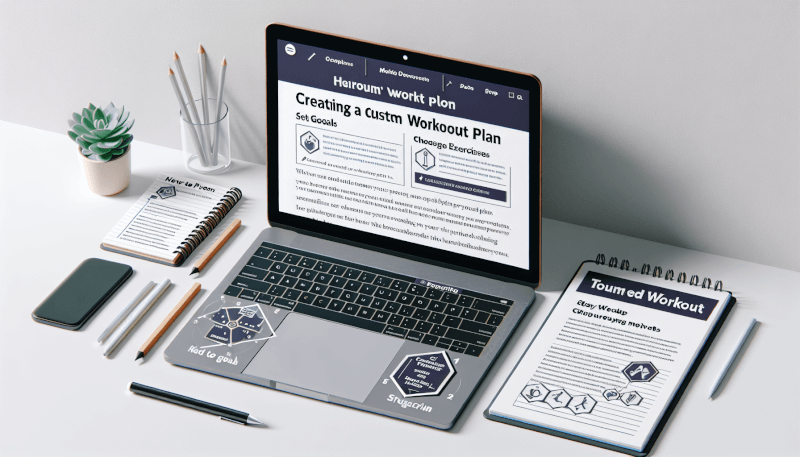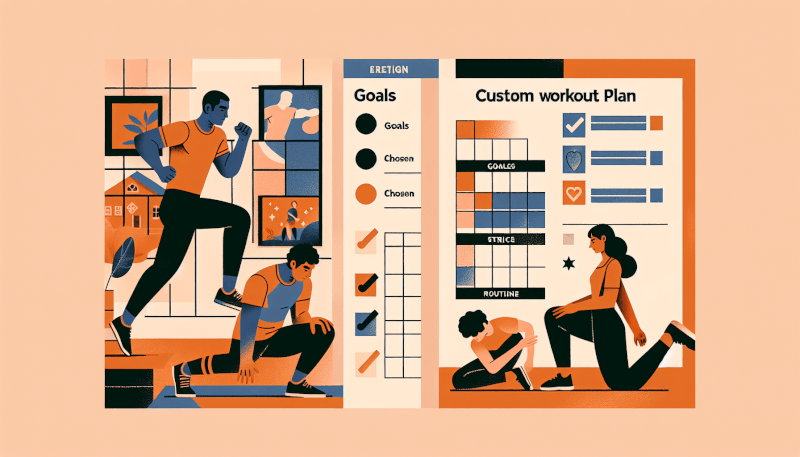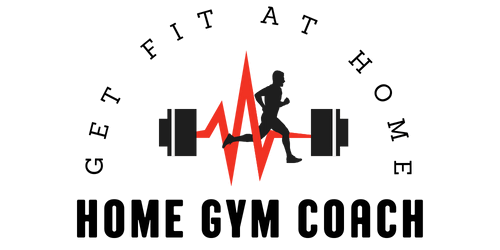Are you tired of the same old workout routine? Are you ready to take your fitness goals to the next level but don’t know where to start? Look no further! In this article, we will guide you through the process of creating a custom workout plan specifically designed for home workouts. Whether you’re a beginner or an experienced fitness enthusiast, we’ve got you covered with tips and tricks to help you maximize your results and stay motivated. Get ready to transform your home into your personal fitness haven and achieve the body of your dreams. Let’s get started!
Determining Your Fitness Goals
Assessing your current fitness level is an important first step in creating a custom workout plan. Take some time to evaluate your strengths and weaknesses, as well as any specific areas you would like to improve on. Are you looking to lose weight, build muscle, increase endurance, or improve flexibility? Understanding your fitness goals will help you tailor your workout plan to suit your needs.
Setting achievable goals is key to maintaining motivation and staying on track. Be realistic with yourself and consider what is attainable within your current circumstances. Whether it’s aiming to lose a certain number of pounds or being able to run a specific distance, setting measurable goals will help you gauge your progress along the way.
Identifying specific areas to target can help you focus your workouts and make them more effective. If you have a particular muscle group that you want to strengthen, such as your core or glutes, you can incorporate exercises that specifically target those areas. This will help you achieve balanced and well-rounded fitness results.
Choosing the Right Exercises
Selecting exercises based on your goals is crucial in creating a effective workout plan. For example, if you’re aiming to build muscle, incorporating weightlifting exercises like squats, deadlifts, and bench presses would be beneficial. If weight loss is your goal, cardiovascular exercises such as running, cycling, or aerobics can help you burn calories and increase your heart rate.
Consider equipment availability when choosing exercises for your workout plan. If you have access to a gym or own a set of dumbbells, you’ll have more options to choose from. However, if you’re limited on equipment, don’t worry! There are plenty of bodyweight exercises that can be just as effective. Think push-ups, lunges, squats, and planks – all of which can be done without any equipment.
Incorporating both cardiovascular and strength exercises into your workout plan is important for overall fitness. Cardio exercises help improve heart health, burn calories, and increase endurance, while strength exercises build muscle and improve bone density. Finding a good balance between the two will ensure you’re getting a well-rounded workout routine.

Designing Your Workout Schedule
Determining how many days per week to exercise is a personal decision based on your availability and fitness level. Aim for at least three days of exercise per week to start, and gradually increase the number of days as you get stronger and more comfortable with your routine. Remember, consistency is key!
Allocating time for warm-up and cool-down is essential to prepare your body for exercise and aid in recovery. Warm-up exercises such as jogging in place, jumping jacks, or dynamic stretches should be done for about 5-10 minutes before each workout. Similarly, cool-down exercises like static stretches or a slow walk will help your body gradually return to its resting state.
Deciding on the duration of each workout session depends on your fitness goals and personal preferences. Some people prefer shorter, more intense workouts, while others enjoy longer sessions. Aim for at least 30 minutes of exercise per session, but feel free to adjust based on your schedule and fitness level.
Creating a Balanced Routine
Incorporating exercises for different muscle groups is essential to prevent muscle imbalances and ensure overall strength and stability. Include exercises that target your upper body, lower body, core, and back. This can be achieved through a combination of exercises such as push-ups, squats, planks, and rows.
Balancing cardio and strength training is important for a well-rounded fitness routine. If you’re focusing on building strength, schedule strength workouts on alternate days with cardio workouts. This allows your muscles time to recover and grow. If weight loss is a priority, consider combining cardio and strength exercises within the same workout session to maximize calorie burn.
Including flexibility and mobility exercises in your routine will help improve range of motion and prevent injuries. Stretching exercises like yoga or Pilates can be incorporated into your warm-up or cool-down routine. Additionally, foam rolling or using a massage ball can help alleviate muscle tightness and improve mobility.

Progression and Adaptation
Gradually increasing intensity and difficulty is important to challenge your body and continue seeing progress. As you get stronger, try increasing the weight or resistance in your strength exercises. For cardiovascular exercises, you can increase the duration or intensity of your workouts. Small increments over time can make a big difference in your fitness level.
Modifying exercises to fit your abilities is crucial to prevent injuries and ensure proper form. If a certain exercise is too challenging, try a modified version or use lighter weights. It’s better to perform an exercise correctly with less weight or intensity than to risk injury by pushing yourself too hard.
Tracking progress and making adjustments will help you stay motivated and continue seeing results. Keep a workout journal or use a fitness app to record your workouts, sets, and reps. This will allow you to see how far you’ve come and make any necessary adjustments to your workout plan.
Safety Precautions
Consulting with a healthcare professional before starting any new exercise program is important, especially if you have any pre-existing medical conditions or have been sedentary for a long time. They can provide guidance on any modifications or precautions you should take based on your individual needs.
Using proper form and technique during exercises is crucial to prevent injuries and ensure maximum effectiveness. If you’re unsure about how to perform an exercise correctly, consider working with a personal trainer or watching instructional videos online. They can help guide you through proper form and technique.
Listening to your body and avoiding overexertion is key to preventing injuries and burnout. Pay attention to any pain, discomfort, or excessive fatigue during your workouts. If something doesn’t feel right, don’t push through it. Give your body time to rest and recover.

Utilizing Online Resources
Exploring workout videos and tutorials online is a great way to find new exercises and workout ideas. There are countless fitness influencers and trainers who share their expertise and provide step-by-step instructions for different workouts. Find a few reliable sources that align with your fitness goals and incorporate their workouts into your routine.
Finding reputable fitness apps and websites can also be a valuable resource for creating a custom workout plan. Many apps offer workout tracking, customized workout plans, and instructional videos. Websites like Bodybuilding.com or ACE Fitness provide articles, workout plans, and educational resources to help you customize your workouts.
Joining online workout communities or forums can provide a sense of accountability and support. Connect with like-minded individuals who share similar fitness goals and challenges. Share your progress, ask for advice, and cheer each other on. It’s a great way to stay motivated and inspired.
Making the Most of Limited Space
Identifying alternative exercises for small spaces is crucial, especially if you’re working out at home. Thankfully, there are plenty of exercises that can be done in a limited space. Think bodyweight exercises like burpees, mountain climbers, or jump squats. You can also use resistance bands or suspension trainers for added intensity.
Maximizing the use of furniture and household items is a creative way to incorporate exercise into your routine. Use a chair for tricep dips or step-ups, a table for incline push-ups, or water bottles as hand weights. Get creative with what you have available and turn your home into your personal gym.
Creating a designated workout area can help you stay organized and motivated. Choose a space in your home that is free of distractions and has enough room for you to move around comfortably. Whether it’s a spare bedroom, a corner of your living room, or your backyard, make it your dedicated workout space.

Staying Motivated and Accountable
Setting realistic expectations is crucial to maintaining motivation. Results take time, so be patient with yourself. Celebrate small wins along the way and appreciate the progress you’re making. Remind yourself of your goals and why you started on this journey.
Finding workout buddies or accountability partners can make your fitness journey more enjoyable and help you stay committed. Whether it’s a friend, family member, or coworker, having someone to share your workouts with and hold you accountable can make a big difference. Set goals together, track progress, and support each other along the way.
Rewarding yourself for reaching milestones is a great way to stay motivated. Treat yourself to something you enjoy, like a massage, a new workout outfit, or a day off from exercise. Rewards can help reinforce positive habits and make your fitness journey more enjoyable.
Modifying Your Plan as Needed
Listening to your body and adjusting your workout plan accordingly is important. If you’re feeling overly fatigued or experiencing any pain, it may be a sign that you need to take a rest day or modify your workouts. Pay attention to how your body responds to different exercises and adjust accordingly.
Adapting to changes in your schedule or circumstances is inevitable, but it doesn’t mean you have to give up on your fitness goals. If you’re unable to follow your planned workout schedule, be flexible and find alternative ways to stay active. Take a walk during your lunch break, do a quick bodyweight workout at home, or try a new form of exercise.
Seeking professional guidance for specialized goals is beneficial if you have specific fitness aspirations. Whether it’s training for a marathon, preparing for a competition, or rehabilitating an injury, a certified personal trainer or fitness coach can provide personalized guidance to help you achieve your goals safely and effectively. They can customize a workout plan, provide expert advice, and monitor your progress.
Creating a custom workout plan for home workouts requires careful consideration of your fitness goals, available resources, and personal preferences. Assess your current fitness level, choose exercises that align with your goals, design a workout schedule, and don’t forget about safety precautions and online resources. With dedication and determination, you can create a workout plan that will help you achieve your desired results from the comfort of your own home.



